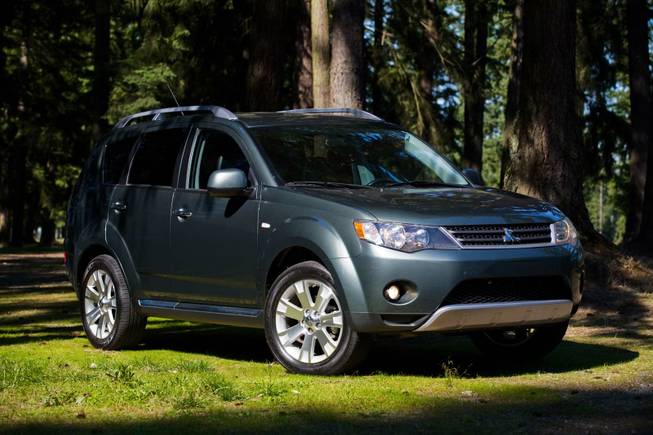
This photo released by Mitsubishi shows the 2009 Mitsubishi Outlander.(AP Photo/Mitsubishi)
Thursday, Jan. 29, 2009 | 4:48 p.m.
Mitsubishi's smallest sport utility vehicle in the United States is still called a compact. But there's not much that's small about the 2009 Outlander.
Stretching more than 15 feet in length, the second-generation Outlander is longer, overall, than many more popular compact SUVs, such as the Honda CR-V and Toyota RAV4. Its 73 cubic feet of cargo area behind the front seats is bigger than those found in the Hyundai Tucson and Nissan Rogue.
And the Outlander's 18-inch wheels on top-of-the-line XLS models, plus big, awesome sound from its optional, 650-watt Rockford Fosgate audio system add to the outsize image.
Unfortunately, the Outlander's prices can be a bit large, too, for a low-volume crossover SUV facing lots of competition.
For example, starting manufacturer's suggested retail price, including destination charge, of $21,095 for a base, four-cylinder, front-wheel drive Outlander is just $580 less than a base Honda CR-V. Starting MSRP, including destination charge, for a 220-horsepower, V-6 powered Outlander is $25,095, but that's more than the $24,280 starting retail price for a V-6 powered 2009 RAV4 from Toyota that puts out 269 horsepower.
To be sure, the new Outlander ties the CR-V, RAV4, Rogue and others in top, five-out-of-five-stars ratings in federal government frontal and side crash tests. All safety features, including curtain air bags, electronic stability control, traction control and antilock brakes are standard on the Outlander.
And Consumer Reports give it a "very good" reliability rating, too.
But given the slow sales of Mitsubishis in this country — 14 CR-Vs were sold last year for every one Outlander — and the automaker's inconsistent marketing efforts over the years, it's easy to see how the Outlander can be overlooked by shoppers.
Like all crossovers, it's based on a car chassis — this one borrowed from the Mitsubishi Lancer sedan. Yet, the ride height in the Outlander is higher than that in a regular car, so passengers get good views out in the traffic.
The ride can be quite pleasant, and handling is nimble and agile as Mitsubishi has improved the rigidity of the car body and the sturdiness of the platform over the years.
Components in the front suspension — struts and coil springs — and a multilink configuration with coil springs in the rear are similar to those in the CR-V and RAV4.
Steering in the test Outlander XLS was nicely responsive without being nervous, and brakes worked well in a variety of maneuvers. I was especially impressed by its composure during emergency situations.
The exterior styling is attractive, too, in a mainstream sense. The test vehicle didn't attract attention, but it didn't look weird, either.
Inside, though, hard plastic pieces and a ho-hum dashboard design aren't inviting. And I'm saying this about the top-of-the-line trim level, the XLS, which was in the test Outlander.
I loved the premium audio system with Sirius satellite radio, and the well-placed left dead pedal for the driver to use for bracing during spirited driving.
The front-seat heaters were the hottest I've experienced, but I wished for a stronger-sounding horn.
There also was a slight electrical, high-pitch whine in the test SUV that bugged me, and it wasn't tied to the gears, ventilation, lights or anything else I could turn on and off or adjust.
Second-row doors don't open quite as wide as those on some other vehicles.
But the second-row floor is flat and provides decent legroom for passengers. For example, with the front seat up a ways, I could extend my legs while sitting in the second row but the seat cushion is flat and benchlike.
The two seats in the third row are best suited for kids only. Adults sit cramped with knees up to their chins, on thin-feeling seat cushions. Rearmost windows don't open, so there's no fresh air, and this seating area is quite close to the rear tailgate.
Thankfully, these third-row seats fold into the floor, but be warned: The process to get them there and get them out again is complicated.
Second-row seats also fold down but some muscle was needed in the test vehicle because seatbacks were heavy.
Check out the split tailgate at the back of the Outlander. Part of this rearmost door moves upward, while part of it pulls downward like that on a pickup truck.
Capable of holding some 400 pounds, this small tailgate is great for tailgate parties. The optional 115-volt power outlet comes in handy for tailgating, too.
Mitsubishi retains its 3-liter, double overhead cam V-6 with MIVEC variable valve timing system for 2009. It's mated to a smooth-shifting, six-speed automatic and really gives the Outlander verve and pep. I rocketed out of the driveway the first day behind the wheel, not expecting such power.
Indeed, it was easy to spin the tires at startup from stoplights. The test Outlander had low-profile, 18-inch tires.
Torque peaks at 204 foot-pounds at 4,000 rpm, but I wished the engine sounds in the test vehicle were more refined and less strained.
Unfortunately, my fuel mileage wasn't great, averaging 19 miles per gallon in city/highway travel.
The base 168-horsepower, 2.4-liter four cylinder is better, with a government rating of 20/25 mpg. But there are small SUVs that get better gas mileage.
And the Outlander's four cylinder, with peak torque of 167 foot-pounds at 4,100 rpm, can sound a bit stressed during hard acceleration.

Join the Discussion:
Check this out for a full explanation of our conversion to the LiveFyre commenting system and instructions on how to sign up for an account.
Full comments policy